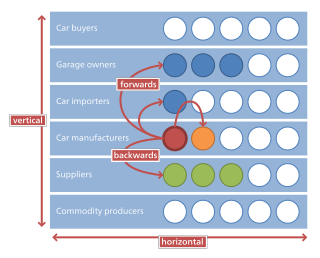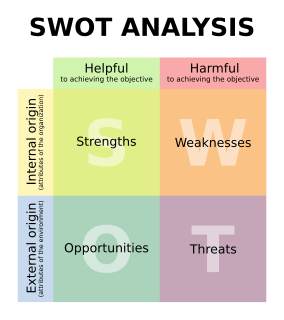 W
WThe Ansoff Matrix is a strategic planning tool that provides a framework to help executives, senior managers, and marketers devise strategies for future growth. It is named after Russian American Igor Ansoff, an applied mathematician and business manager, who created the concept.
 W
WA business model describes the rationale of how an organization creates, delivers, and captures value, in economic, social, cultural or other contexts. The process of business model construction and modification is also called business model innovation and forms a part of business strategy.
 W
WA crisis is any event or period that will lead, or may lead, to an unstable and dangerous situation affecting an individual, group, or all of society. Crises are negative changes in the human or environmental affairs, especially when they occur abruptly, with little or no warning. More loosely, a crisis is a testing time or an emergency.
 W
WCritical success factor (CSF) is a management term for an element that is necessary for an organization or project to achieve its mission. To achieve their goals they need to be aware of each key success factor (KSF) and the variations between the keys and the different roles key result area (KRA).
 W
WThe growth–share matrix is a chart that was created by Bruce D. Henderson for the Boston Consulting Group in 1970 to help corporations to analyze their business units, that is, their product lines. This helps the company allocate resources and is used as an analytical tool in brand marketing, product management, strategic management, and portfolio analysis. Some analysis of market performance by firms using its principles has called its usefulness into question.
 W
WHorizontal integration is the process of a company increasing production of goods or services at the same part of the supply chain. A company may do this via internal expansion, acquisition or merger.
 W
WIndia Reloaded: Inside India's Resurgent Consumer Market is a 2015 book that was written by Dheeraj Sinha. It was first published on July 24, 2015, through Palgrave Macmillan and examines India' consumer market.
 W
WLeadership is both a research area, and a practical skill encompassing the ability of an individual, group or organization to "lead", influence or guide other individuals, teams, or entire organizations. Often viewed as a contested term, specialist literature debates various viewpoints, contrasting Eastern and Western approaches to leadership, and also North American versus European approaches.
Marlin & Associates (M&A) is a New York City based boutique investment banking and strategic advisory firm, advising owners and managers of U.S. and international companies in the technology, digital information, and healthcare-related sectors.
 W
WA mind map is a diagram used to visually organize information. A mind map is hierarchical and shows relationships among pieces of the whole. It is often created around a single concept, drawn as an image in the center of a blank page, to which associated representations of ideas such as images, words and parts of words are added. Major ideas are connected directly to the central concept, and other ideas branch out from those major ideas.
 W
WIn R&D management and systems development, open coopetition or open-coopetition is a neologism to describe cooperation among competitors in the open-source arena. The term was first coined by the scholars Jose Teixeira and Tingting Lin to describe how rival firms that, while competing with similar products in the same markets, cooperate which each other in the development of open-source projects in the co-development of Webkit).
 W
WPorter's Five Forces Framework is a method for analysing competition of a business. It draws from industrial organization (IO) economics to derive five forces that determine the competitive intensity and, therefore, the attractiveness of an industry in terms of its profitability. An "unattractive" industry is one in which the effect of these five forces reduces overall profitability. The most unattractive industry would be one approaching "pure competition", in which available profits for all firms are driven to normal profit levels. The five-forces perspective is associated with its originator, Michael E. Porter of Harvard University. This framework was first published in Harvard Business Review in 1979.
 W
WThe business terms push and pull originated in logistics and supply chain management, but are also widely used in marketing and in the hotel distribution business.
 W
WService parts pricing refers to the aspect of service lifecycle management that deals with setting prices for service parts in the after-sales market. Like other streams of pricing, service parts pricing is a scientific pursuit aimed at aligning service part prices internally to be logical and consistent, and at the same time aligning them externally with the market. This is done with the overarching aim of extracting the maximum possible price from service parts and thus maximize the profit margins. Pricing analysts have to be cognizant of possible repercussions of pricing their parts too high or too low in the after-sales market; they constantly have to strive to get the prices just right towards achieving maximum margins and maximum possible volumes.
 W
WStrategic competitiveness is accomplished when a firm successfully integrates a value-creating strategy. The key to having a complete value-creating strategy is to adopt a holistic approach that includes business strategy, financial strategy, technology strategy, marketing strategy and investor strategy. The objective of the firm has to be based on creating value in an efficient way because it is the starting point for all businesses and it will generate profit after cost. Eric Beinhocker, the Executive Director of the Institute for New Economic Thinking at the Oxford Martin School, University of Oxford, says in his book The Origin of Wealth that the origin of wealth is knowledge. Knowledge does not have to be perceived as an assumption, or as an external factor. It has to be in the heart of the business. For this reason, the value-creating strategy must include a thorough knowledge of each area of the company in order to develop a competitive advantage.
 W
WStrategic energy management (SEM) is a set of processes for business energy management. SEM is often deployed via programs that target the businesses or other organizations within a utility territory or a government area. SEM is codified in the ISO 50001 standard for energy management systems.
 W
WStrategic financial management is the study of finance with a long term view considering the strategic goals of the enterprise. Financial management is nowadays increasingly referred to as "Strategic Financial Management" so as to give it an increased frame of reference.
 W
WSWOT analysis is a strategic planning technique used to help a person or organization identify strengths, weaknesses, opportunities, and threats related to business competition or project planning.
 W
WA vision statement is an inspirational statement of an idealistic emotional future of a company or group. Vision describes the basic human emotion that a founder intends to be experienced by the people the organization interacts with, it grounds the group so it can actualize some existential impact on the world.
 W
WZaibatsu is a Japanese term referring to industrial and financial vertically integrated business conglomerates in the Empire of Japan, whose influence and size allowed control over significant parts of the Japanese economy from the Meiji period until the end of World War II. A zaibatsu's general structure included a family owned holding company on top, and a bank which financed the other, mostly industrial subsidiaries within them. Although the zaibatsu played an important role in the Japanese economy from the 1860s to 1945, they increased in number and importance following the Russo-Japanese War of 1904–1905, World War I and Japan's subsequent attempt to conquer East Asia during the inter-war period and World War II. After World War II they were dissolved by the Allied occupation forces and succeeded by the keiretsu.